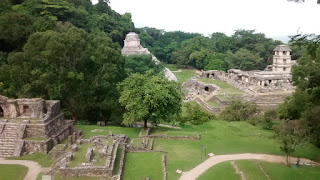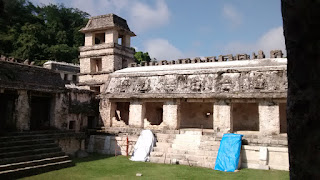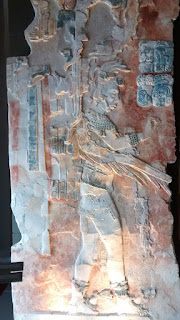Fear drove me. What if I never made it back to this area? Would I regret not having visited? Fear and determination to outdo any other Mayan ruins tourist that I met with stories of who had gone the furthest to see ruins. I've always been a bit competitive.
 |
On the Usumacinta River.
Mexico to the left. Guatemala to the right. |
Yaxchilan. Part of the adventure of visiting Yaxchilan is the journey. From the ruins of Palenque, it is another 155 kilometers away (96 miles). Google maps does not predict enough time for stopping every 2-3 kilometers for speed bumps. After arriving, you need to take a lancha along the Usamacinta River, which is the border between Guatemala and Mexico. The ride is between 40-60 minutes. There is a possibility of seeing crocodiles; but, thankfully, I did not. (If my lancha driver saw any, he wisely did not point them out to me.) While the park entrance is free on Sundays for Mexican nationals and residents, the lancha ride is not.
 |
| Small Acropolis |
Due to the late hour (we docked at the site at 3:30 pm; and, the park closes at 4:30 pm), I got in my workout running up and down series of steps. For once, the Moon guidebook provided useful information -- it recommended going up the stairs to the Small Acropolis first because then the rest of the visit would be downhill. I jogged, walked, trudged my way up to the Small Acropolis. There was a group of high school students just finishing their tour, coming up the stairs from the other side. They looked exhausted. They were also the last tourists that I would see in the park.
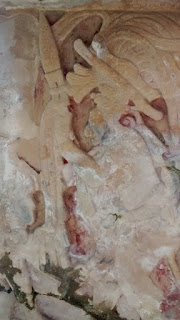 |
| Lintel carving |
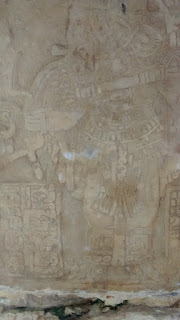 |
| Lintel carving |
One of the interesting architectural features of Yaxchilan are the lintels over doorways. A peek underneath; and, intricate bas-relief carvings are largely intact. The paint on the carvings unfortunately has not stood the elements. The Small Acropolis has three different lintels, of which two are mostly intact.
 |
| Buildings 39, 40, 41 |
I quick-stepped down the Small Acropolis and took off in a jog down the trail. There was a turn-off for buildings 39, 40, 41. Checking the time, I thought that I could make it up and back. Jog, walk, trudge and finally made it to the top to see these three temples. During the entire time, there were these loud noises emanating from the forest. A bit frightening, actually. And, the trail was taking me closer to them! But, I was alone (or, so I thought until I heard the familiar sound of a text and saw a park guard sitting atop Building 39).
 |
| Coming upon Building 33 |
Time was running out, I jogged back down to the main trail as quickly as I could, avoiding rocks and tree roots. To the right and on it went. Through the trees, a structure started to take shape. However, there was a lot of action going on in the trees above me. Animals quite large were rustling in the trees and jumping from tree to tree. To announce myself, I started whistling random notes very loudly. The tree action slowed a bit. Here and there, a tail poked down from the foliage. Monkeys!
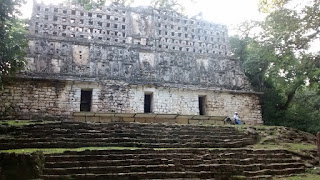 |
| Building 33 |
I climbed up to the large building, continuing to whistle, all my stuff tucked tightly in my purse, just in case these monkeys were handsy. But, not a one of them descended to investigate the intruder in their jungle. In front, the building (originally named Building 33) is even more impressive! Inside, there is a seated sculpture. On the lower level, covered by the shades, there are the remains of bas-relief sculptures. From here, a long set of stairs descended into the main plaza below.
 |
| Looking down toward the main plaza |
In the plaza, there were multiple stelaes still standing, covered with small roofs for protection. Some of them were in pretty good shape, as was one now on it's back that had twice thwarted people trying to move it from the site.
 |
| In the 1960s, a failed attempt was made to transport this stelae to the National Museum of Anthropology in Mexico City. |
By this time, one of the park workers had struck up a conversation with me. He told me that the scary animal noises were howler monkeys and pointed out a toucan flying by. The park worker recommended the highlights that I needed to see before the park closed. His best tip was walking through the building that is called the Labyrinth. It is open to walk through; but, make sure to bring some kind of light. Inside the building, the original white stucco remains. The main occupants today are bats. Somehow, they cling to the white stucco A-frame ceilings. We turned our cell phones into flashlights and walked through the labyrinth, coming out a back entrance.
 |
| Inside the Labyrinth (bats hanging above us) |
We walked back to the entrance. During the walk, the park worker told me how people used to come out and camp at Yaxchilan in order to see the ruins. The park workers still do. I speculated out loud that there couldn't possibly by many visitors since it was so tough to access. But, he said that there had been 150 visitors that day. Then, I raced down the stairs to Juan and his lancha waiting at the boat dock. The ride back was beautiful. A haze was over the water; and, dusk was approaching.
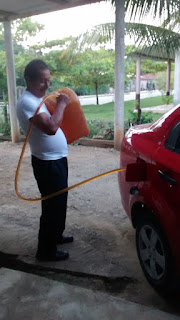 |
| Pumping gas at Yaxchilan's gas station |
My final adventure of the night? Going to the "gas station". In Yaxchilan, it's a man and his wife selling gas from their house. You can purchase either 10 liters or 20 liters. They bring out a tank of the appropriate size and plastic tubing. Through some combination of blowing or sucking air into the tubing, the gas flows into the tank. The man told me that they brought the gas in barrels from the Pemex in Chancala, over 100 km away.
Tips:
Zona Archeaological Yaxchilan. Free on Sundays for Mexican nationals and residents. Lancha ride is 40-60 minutes. I don't know how much it costs for a group. For just me, he asked for 1200 pesos; but, we finally agreed on 800 pesos round trip.











